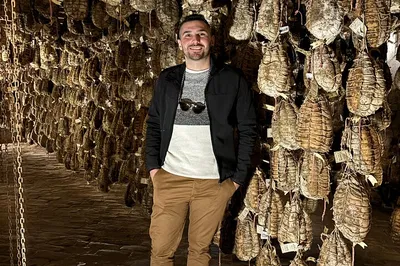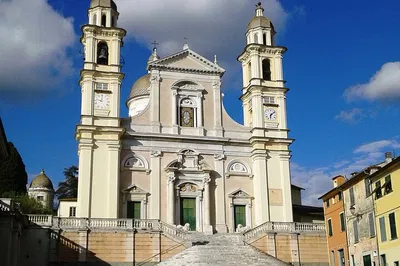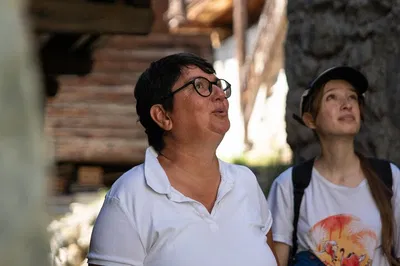Milan Fiat 500 Tour: See Top Sights in Style!
180
Overview
The 3-hour Vintage Fiat 500 Big Central City Tour in Milan offers a unique way to explore the city's most exciting neighborhoods. This tour takes visitors through the heart of Milan in a classic Fiat 500, showcasing the city center, the Navigli Canals District, and the modern Garibaldi Skyline District. It's a fun and memorable experience for anyone who wants to see Milan from a different perspective.
During the tour, there are three stops where guests can get out and explore on their own. A tour leader/driver waits at the car to continue the journey to the next destination. The tour visits iconic locations such as the Royal Villa of Milan (Villa Belgiojoso Bonaparte), Porta Nuova (Medieval), the artistic Brera District, and the historic Sforzesco Castle. Guests will also see the quirky Needle, Thread, and Knot sculpture (Piazzale Cadorna), the beautiful Basilica of Santa Maria delle Grazie, and the serene Church of San Maurizio al Monastero Maggiore. Plus, they'll encounter modern art like L.O.V.E. (The Finger) and stroll along Via Torino, seeing the Basilica of San Lorenzo and the Church of San Bernardino alle Ossa.
The tour also covers the historical Via Laghetto and Santo Stefano Lake, the University of Milan (La Statale), the Palace of Justice (Palazzo di Giustizia), and Rotonda della Besana. Discover the Navigli District, and see San Vittore Prison, Triennale Milano, Torre Branca, Arco della Pace (Porta Sempione), Gianni Brera Civic Arena, Monumental Cemetery, Rainbow Tower, UniCredit Tower Complex, Bosco Verticale (Vertical Forest), Diamond Tower (Diamantone), Milan Central Station, Rasini Tower, Palazzo Serbelloni, Snia Viscosa Tower (San Babila Tower), and Milan Cathedral (Duomo). The 3-hour Vintage Fiat 500 Big Central City Tour includes three stops for exploring on foot, an English-speaking tour leader/driver, and the use of a classic red Fiat 500. Note that this tour does not include air conditioning, air bags, seat belts, onboard Wi-Fi, or restrooms.

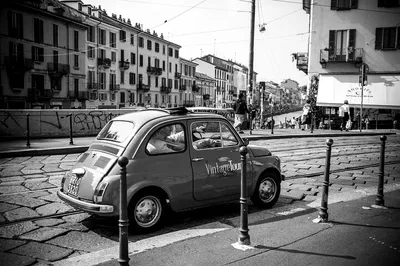
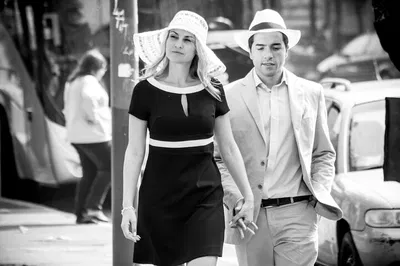

Highlights
Cruise Milan in a Classic Fiat 500: See Milan's top sights from a fun, vintage car.
Explore 3 Cool Milan Neighborhoods: Visit the city center, canals, and modern skyline areas.
Enjoy 3 Stops to Walk Around: Get out and see key spots up close on your own.
English-Speaking Guide: A friendly driver tells you about the city.
Sentiment Analysis
Customers really enjoy seeing Milan in a vintage Fiat, even though some wish the stops were longer and the cars had air conditioning. The guides are a highlight for many.

Customers say riding in the Fiat 500 is a super fun way to see Milan.
Many loved seeing the city's cool spots with a friendly guide.
People felt the tour was a great way to get around and see lots of things.
The guides are very friendly and knowledgeable, sharing details about Milan and answering questions.
Some people mentioned the cars can be a bit hot on warm days.
A few wished for more time at each stop to look around.
The Journey
Royal Villa of Milan (Villa Belgiojoso Bonaparte)
Nestled in front of the Giardini Montanelli, the Royal Villa, also known as Villa Belgiojoso Bonaparte, is a neoclassical masterpiece built in the late 18th century by Leopoldo Pollack. Commissioned by Count Ludovico Barbiano of Belgiojoso, its English-style gardens offer a serene escape in the heart of the city. Today, it houses the Modern Art Gallery, making it a cultural gem that blends history, art, and tranquil beauty. A must-visit for art lovers and those seeking respite from the urban bustle.
Porta Nuova (Medieval)
The Medieval Arches of Porta Nuova stand as a testament to Milan's rich history. As one of the largest gates in the city's medieval walls, it offers a glimpse into Milan's past, when fortified gates were crucial for defense and trade. Visiting Porta Nuova is like stepping back in time, allowing you to appreciate the city's architectural heritage and imagine life within its ancient boundaries.
Brera District
The elegant Brera district is a vibrant hub of art, culture, and sophistication. Wander through its charming streets to discover the renowned Brera Art Gallery, the tranquil Botanical Garden, and the historic Church of Santa Maria del Carmine. Indulge in luxury shopping and savor exquisite cuisine at elegant bars and restaurants. Don't miss the Leonardo-designed lock at the end of Via San Marco, a testament to Milan's innovative spirit. Brera promises an immersive experience for art enthusiasts, foodies, and those seeking a taste of Milanese elegance.
Sforzesco Castle
The Sforzesco Castle, a large fortified complex just outside Milan's historic center, is a monument to Milan's powerful past. Built in the 15th century by Francesco Sforza on the remains of the earlier Porta Giovia Castle, it offers a journey through history and art. Explore its courtyards, museums, and ramparts to uncover centuries of stories and appreciate the grandeur of Renaissance architecture. Perfect for history buffs and anyone wanting to delve deeper into Milan's rich heritage.
Needle, Thread and Knot (Piazzale Cadorna)
Located in Piazzale Cadorna, a crucial transport hub in Milan, Needle, Thread, and Knot is a striking two-part sculpture by Claes Oldenburg and Coosje van Bruggen. This vibrant and thought-provoking artwork serves as a monument to Milanese fashion and creativity. Its bold design and strategic placement make it a must-see landmark for art lovers and travelers passing through the city.
Basilica of Santa Maria delle Grazie
The Basilica of Santa Maria delle Grazie, a UNESCO World Heritage site, stands as a beacon of Renaissance art in the heart of Milan. Home to Leonardo da Vinci's masterpiece, 'The Last Supper,' this basilica offers an unparalleled artistic and spiritual experience. Marvel at the architectural grandeur and immerse yourself in the historical significance of this iconic landmark. A visit here is a must for anyone seeking to witness the pinnacle of human creative genius.
Church of San Maurizio al Monastero Maggiore
Referred to as the 'Sistine Chapel of Milan,' the Church of San Maurizio al Monastero Maggiore boasts an architectural structure and decorative cycle of exceptional quality, crafted by the Leonardesque school. The interior is adorned with stunning frescoes that create a mesmerizing visual experience. This hidden gem offers a serene and artistic escape, inviting visitors to marvel at its beauty and historical significance.
L.O.V.E. (The Finger)
L.O.V.E. (Freedom, Hate, Vengeance, Eternity), commonly known as 'The Finger,' is a provocative sculpture by Maurizio Cattelan located in front of the Palazzo della Borsa (Stock Exchange). This controversial artwork challenges perceptions and sparks conversation, making it a must-see for those interested in contemporary art and social commentary. Its bold presence in Milan's financial district provides a striking contrast and an unforgettable visual statement.
Via Torino
Via Torino, one of Milan's oldest streets, is a vibrant commercial thoroughfare connecting Piazza Duomo with the Navigli area. Known for its long-standing tradition of shops and boutiques, it offers a bustling shopping experience and a lively atmosphere. Stroll along this historic street to discover a blend of modern retail and traditional charm, capturing the essence of Milan's dynamic urban landscape.
Basilica of San Lorenzo
Dating back to the 4th century, the Basilica of San Lorenzo once stood outside Milan's city walls, near the amphitheater and imperial palace. This ancient basilica, along the Via Ticinensis, was a prominent landmark for those entering Milan. Today, it stands as a testament to the city's rich history and architectural evolution. Its imposing size and historical significance make it a fascinating destination for history enthusiasts and those seeking to explore Milan's ancient roots.
Church of San Bernardino alle Ossa
Located in Piazza Santo Stefano, the Church of San Bernardino alle Ossa is renowned for its unique and macabre ossuary chapel. Its walls are adorned with human bones arranged in baroque decorations, creating a chilling yet strangely beautiful spectacle. This unusual and thought-provoking site offers a glimpse into Milan's past and the cultural fascination with mortality, making it a memorable and intriguing visit.
Via Laghetto and Santo Stefano Lake (Historical Site)
Via Laghetto derives its name from the small lake of Santo Stefano, which played a crucial role in the construction of the Milan Cathedral. In the late 1300s, this lake was used to transport Candoglia marble, reducing the cost of construction. Explore this historical site to understand the ingenuity and resourcefulness behind Milan's architectural marvels, and to appreciate the connection between the city's natural resources and its grandest structures.
University of Milan (La Statale)
The University of Milan, known as 'La Statale,' is a prestigious public university founded in 1923. Its main headquarters are housed in the Renaissance building of 'Ca' Granda,' originally commissioned as the city's hospital by Duke Francesco Sforza. Explore the historic courtyards and architecture of this educational landmark, which embodies Milan's dedication to learning and cultural heritage. A great place to appreciate the blend of academic rigor and architectural grandeur.
Palace of Justice (Palazzo di Giustizia)
Constructed between 1932 and 1940 under the direction of Marcello Piacentini, the Palace of Justice is a significant example of 20th-century architecture in Milan. Its construction required the demolition of the church of San Filippo Neri and the convent of the Slaves of Mary. This imposing structure reflects the city's historical and architectural transformations, making it a notable point of interest for those studying urban development and architectural styles.
Rotonda della Besana
The Rotonda della Besana is a late Baroque cemetery complex in Milan, featuring a long, enclosed portico and the former church of San Michele ai Nuovi Sepolcri, built in 1695. Today, it houses the MU.BA, a children's museum, blending history and education. Explore this unique site to appreciate its architectural beauty and its transformation into a space dedicated to children's learning and creativity.
Porta Romana
Porta Romana is one of Milan's six main gates, characterized by a monumental arch commissioned by Philip III of Spain in 1596. Located in Piazza Medaglie d'Oro, at the entrance to Corso di Porta Romana, it stands as a historical landmark along the former Spanish walls. Visit this iconic gate to admire its architectural details and reflect on Milan's historical fortifications and cultural heritage.
Navigli District
The Navigli district of Milan, with its historic canals, once facilitated navigation and the transport of materials for the Milan Cathedral. Leonardo da Vinci contributed improvements to the canal system during the Renaissance. Today, the Navigli district is a vibrant area filled with restaurants and cafes, offering picturesque views and a lively atmosphere. Explore this charming neighborhood to experience Milan's historical waterways and its contemporary cultural scene.
San Vittore Prison
San Vittore Prison, constructed in the late 19th century during the Kingdom of Italy, stands along Viale Papiniano, home to a characteristic open-air market. This penitentiary institution holds historical significance and offers a glimpse into Milan's social and institutional history. While not a typical tourist attraction, its presence adds to the city's complex historical narrative.
Triennale Milano
Triennale Milano, located inside the Palazzo dell'Arte, is a leading cultural institution in Lombardy, internationally recognized for its exhibitions on art, design, architecture, and fashion. It also hosts theatrical shows, performances, concerts, talks, and meetings. Visit Triennale Milano to immerse yourself in contemporary culture and explore the latest trends in creative expression.
Torre Branca
The Torre Branca, originally Torre Littoria, is a steel construction built in 1933 based on a design by the architect Giò Ponti, located inside the Sempione Park in Milan. Offering a 360-degree view of the Milan skyline, this tower provides a unique perspective on the city. Experience Milan from another viewpoint and capture breathtaking panoramic views.
Arco della Pace (Porta Sempione)
The neoclassical Arco della Pace (or Porta Sempione, 1807) was the first of Milan's five newest gates, built along the former Spanish ramparts. Located in the large open space behind the Piazza d'Armi of the Sforzesco Castle, it served as a triumphal entrance to the city from France. Admire its grandeur and historical significance, reflecting Milan's architectural and political past.
Gianni Brera Civic Arena
The Gianni Brera Civic Arena, originally known as the Milan Amphitheater, is a multifunctional sports facility inaugurated in 1807. It became the Civic Arena in 1870 after being acquired by the Municipality. As a historic sporting venue, it offers a glimpse into Milan's athletic heritage and cultural traditions.
Monumental Cemetery
Designed by Carlo Maciachini and opened in 1866, the Monumental Cemetery is a captivating journey through Milan's history. Explore the tombs of notable figures whose names adorn major metro stations, roads, and squares. This site offers an artistic and historical reflection on Milan's past, showcasing impressive sculptures and architectural designs.
Rainbow Tower
Built in 1990 as a colorful homage to Milanese creativity, the Rainbow Tower transformed an anonymous water tank in Porta Garibaldi. Restored for Expo2015, it now shines in its original splendor. This vibrant and unique structure celebrates Milan's artistic spirit and innovative design, making it a cheerful and eye-catching landmark.
UniCredit Tower Complex
The UniCredit Tower complex, designed by Cesar Pelli of Pelli Clarke Pelli, features eco-sustainable buildings in glass and steel. Comprising three towers of varying heights, it dominates Milan's skyline. This modern architectural marvel showcases Milan's commitment to innovation and sustainable development, making it a striking addition to the city's urban landscape.
Bosco Verticale (Vertical Forest)
The Bosco Verticale (Vertical Forest) is an innovative complex of two residential tower buildings designed by Boeri Studio, located on the edge of the Isola district. These towers feature a unique design with trees and vegetation integrated into their structure, promoting biodiversity and urban sustainability. Visit this architectural marvel to witness the future of green urban living.
Diamond Tower (Diamantone)
The Diamond Tower (also called Diamantone) is a skyscraper in Milan's business center, serving as the headquarters for the Italian companies of the BNP Paribas Group. Its distinctive diamond-like shape stands out against the skyline, making it a recognizable landmark of modern architecture in Milan. A great viewing spot for those interested in urban development.
Milan Central Station
Milan Central Station, built starting from the initial project by architect Ulisse Stacchini and inaugurated in 1931, showcases a blend of architectural styles, including Art Deco and Fascist elements. It stands as a testament to Italy's historical and political transformations. During World War II, Track 21 was used to deport Jews to concentration camps. Visit this iconic station to appreciate its grandeur and reflect on its complex history.
Rasini Tower
The Rasini Tower (Emilio Lancia, Gio Ponti) is a historic building in Milan, designed as luxury apartments in the twentieth century style. Located on the corner between Corso Venezia and Porta Venezia, the complex comprises two parts: the Tower and the Palace. Admire its architectural design and historical significance, reflecting Milan's urban development and artistic collaborations.
Palazzo Serbelloni
Palazzo Serbelloni, a splendid example of a neoclassical palace, was built in the second half of the 18th century by Simone Cantoni for the Serbelloni family. This majestic and imposing palace showcases architectural grandeur and historical elegance. Explore its beautiful façade and appreciate the artistic details, reflecting Milan's aristocratic past.
Snia Viscosa Tower (San Babila Tower)
The Snia Viscosa Tower (also known as the San Babila Tower), built in 1937 based on a design by the architect Alessandro Rimini, houses shops, offices, and apartments. This historical structure represents Milan's urban development during the mid-20th century, combining commercial and residential functions in a single building. Observe its architectural details and historical context as you explore the San Babila area.
Milan Cathedral (Duomo)
The Milan Cathedral, or Duomo, is one of the largest Catholic churches in the world, accommodating up to 40,000 people. Its construction began in 1386 under Gian Galeazzo Visconti and took five centuries to complete. The site was previously occupied by the Basilica of Sant'Ambrogio and the Basilica of Santa Tecla. Visit this iconic landmark to marvel at its Gothic architecture, climb to the rooftop for panoramic views, and immerse yourself in centuries of history and art.
Know Before You Go
This tour includes three stops where you can walk around and explore. You'll have an English-speaking tour leader who is also your driver. The tour is in a classic red Fiat 500. Keep in mind that the Fiat 500 does not have air conditioning, air bags, seat belts, or Wi-Fi. There are also no restrooms on board. Make sure to confirm meeting point details before your tour.
Hot Tip
Some visitors suggest bringing water, especially on hot days, since the Fiat 500 doesn't have air conditioning. Others recommend wearing comfortable shoes for the walking portions of the tour. Booking in advance can help secure your spot!


